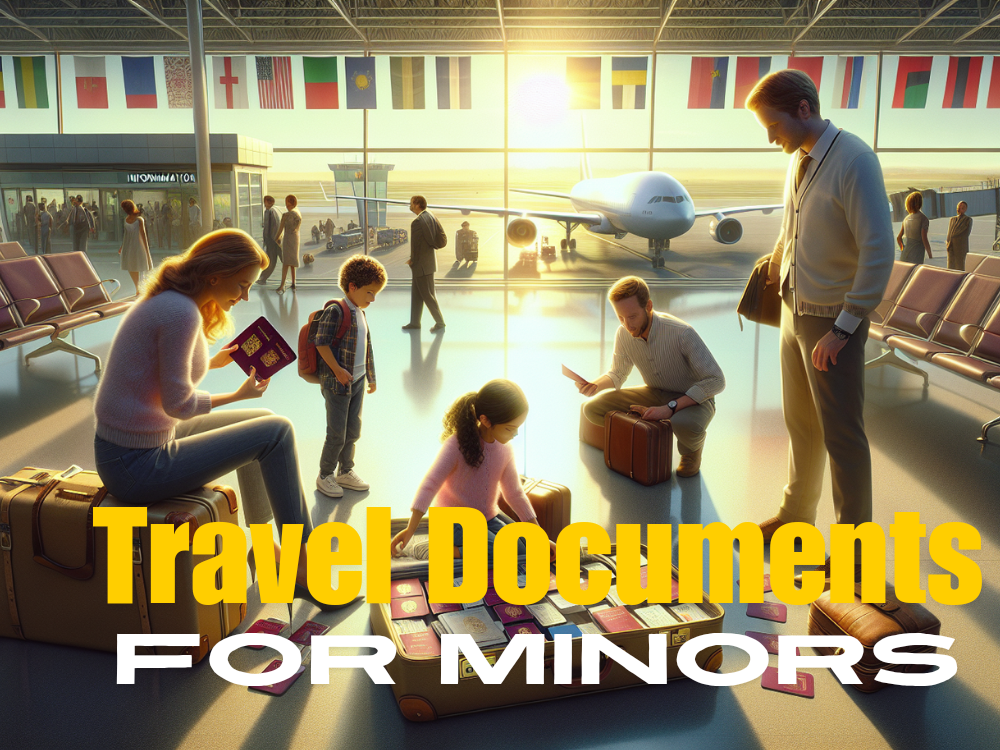
Traveling with children can be an exciting adventure, but it requires careful preparation, especially when it comes to travel documents for minors. Parents and guardians must navigate a complex web of regulations and requirements to ensure a smooth journey for their young ones. From passports and visas to consent forms and medical records, the list of necessary paperwork can seem daunting at first glance.
This article aims to guide parents through the essential travel documents for minors. We’ll explore the regulations governing child travel, delve into the crucial identity documents needed, and discuss the importance of parental authorization. Additionally, we’ll cover the health and safety paperwork that can prove invaluable during trips. By the end, parents will have a clear understanding of what to prepare, helping to make family travel a stress-free and enjoyable experience.
Understanding Minor Travel Regulations
Domestic vs. International Requirements
When traveling with minors, parents and guardians must navigate different regulations for domestic and international flights. For domestic flights within the United States, children under 18 typically do not need personal identification. The ID of the accompanying responsible adult is usually sufficient. However, for international travel, regardless of age, all passengers, including infants, need a valid passport.
Age-specific Guidelines
Airlines have specific age-based guidelines for unaccompanied minors:
- Children under 5 cannot travel alone.
- Children aged 5-7 can travel alone on nonstop and through flights with unaccompanied minor procedures.
- Children aged 8-11 (or 8-14 on some airlines) can usually travel alone on any flight with unaccompanied minor procedures.
- For domestic flights, children aged 12-17 (or 15-17 on some airlines) can travel alone on any flight without restrictions, but unaccompanied minor procedures are available upon request.
It’s important to note that these guidelines may vary slightly between airlines. For instance, American Airlines requires unaccompanied minor service for children aged 5-14, while it’s optional for those aged 15-17.
Transportation Security Administration (TSA) Rules
The TSA has specific rules for children going through security:
- Children aged 13 and older follow the same security screening process as adults.
- Children aged 12 and younger undergo a modified security screening, keeping their shoes and light jackets on.
- Infants must be removed from their strollers and carried through security in their parent’s arms.
- Children’s carry-on items must go on the X-ray belt for screening.
For families traveling with infants and toddlers, the TSA allows drinkable liquids, including breast milk, in excess of the standard 3.4-ounce limit as carry-ons, as they are deemed medically necessary. Parents with TSA PreCheck can extend this benefit to their children aged 12 and under.
Essential Identity Documents
Passports
When traveling internationally with minors, passports are crucial. Regardless of age, every individual, including infants, needs a passport to travel outside the United States. It serves as the child’s primary form of identification abroad and provides official proof of U.S. citizenship.
For children under 16, the passport application process requires:
- Both parents or guardians to apply in person using Form DS-11.
- Providing the child’s Social Security Number (SSN) or a formal statement declaring they don’t have one.
- Showing proof of the child’s citizenship.
Passports for children under 16 are valid for 5 years. For minors aged 16 or 17, the process is slightly different:
- They need to apply in person using Form DS-11 or renew their current passport with Form DS-82.
- The passport book costs $165 and is valid for ten years.
It’s important to note that passport cards differ from passport books. While passport cards allow entry to the U.S. at land border crossings and sea ports from Canada, Mexico, the Caribbean, and Bermuda, they cannot be used for air travel.
Birth Certificates
A certified birth certificate is an official government-issued record of a person’s birth, printed on security paper with an official raised, embossed, impressed or multicolored seal. It’s a crucial document for establishing identity and has several uses:
- Obtaining a Social Security card
- Applying for a U.S. passport
- Applying for a driver’s license
- Proving U.S. citizenship
- Applying for a job
For travel purposes, an original or copy of the birth certificate can be used as identification for children under 16 when entering the U.S. by land or sea from Canada or Mexico.
School IDs
While not as widely accepted as passports or birth certificates, school IDs can serve as a form of picture identification for minors. However, for air travel or international trips, more official forms of identification are typically required.
Parental Authorization and Consent
Travel Consent Letters
Travel consent letters are crucial documents for minors traveling without both parents or legal guardians. These letters demonstrate that the child has permission to travel outside their home country. They are particularly important when a child is traveling alone, with only one parent or guardian, in the care of friends or relatives, or with a group such as a sports team or school.
While not a legal requirement in all countries, travel consent letters can simplify international travel for children. Immigration authorities, airline agents, and border officials may request these documents when entering or leaving a foreign country or when re-entering the home country.
A comprehensive travel consent letter should include:
- The child’s basic information (name, gender, birthday, and place of birth)
- Both parents’ contact information
- Travel arrangements and destination details
- Passport information and birth certificate number for international travel
Custody Documents
For parents with sole legal custody, obtaining permission to travel out-of-state or abroad may not be strictly necessary. However, U.S. Customs and Border Protection recommends carrying relevant documentation such as a court decision, birth certificate naming only one parent, or a death certificate that confirms sole legal custody.
Even in cases of sole custody, it’s important to note that the parent without sole custody often retains access rights or visitation rights. Therefore, having a travel consent form or custody documents on hand can prevent potential issues or misunderstandings during travel.
Notarization Requirements
Many travel authorities require Child Travel Consent forms to be notarized for proof of authenticity. Notarization validates the identities and signatures of the people named in the document, adding an extra layer of credibility. Without notarized consent, border officials could delay or prevent a child from traveling further.
It is highly recommended to have the Child Travel Consent notarized, especially for children under 16 traveling without both legal guardians. This decreases the chance of travel authorities questioning the document’s validity and helps prevent potential child abductions.
Health and Safety Paperwork
Medical Authorization Forms
When traveling with minors, it is crucial to have proper medical authorization forms. A Child Medical Consent Form, also known as a Child Medical Release Form, is a legal document that grants permission to another adult or healthcare provider to seek medical treatment for the child when the parent or guardian is unavailable. This form typically includes the child’s information, parent or guardian details, authorized adult’s information, scope of consent, and duration of consent.
Parents should consider providing a Child Medical Consent Form in various situations, such as:
- When a child is under the care of a babysitter or caregiver
- When a child is traveling without parents
- During school or sports activities
- For summer camps or extracurricular activities
- For medical appointments without a parent present
- In cases of temporary guardianship
Not having a Child Medical Consent Form can lead to delayed medical treatment, legal ambiguity, and complications in emergency situations.
Insurance Information
Travel insurance is an essential consideration for families traveling with children. Many policies allow parents to add children 17 or under at no additional cost, as long as they travel with at least one legal guardian. Some policies even enable grandparents to add children to their coverage.
When selecting family travel insurance, it’s important to assess:
- Travel frequency and duration
- Risk level of the destination
- Budget
- Family members traveling
- Planned activities
For children traveling without parents, specific travel insurance for unaccompanied minors or single-child travel insurance may be necessary.
Allergy and Medication Lists
Parents should prepare a comprehensive list of their child’s allergies and medications before traveling. This information should be included in the Child Medical Consent Form. It’s advisable to bring a kit with all the child’s medications, including extra epinephrine auto-injectors, regardless of the travel distance.
Additional health and safety paperwork to consider includes:
- Extra copies of the Food Allergy & Anaphylaxis Emergency Care Plan
- Contact information for the child’s doctor
- A list of any pre-existing medical conditions
Before traveling, parents should schedule a checkup with a pediatrician to ensure the child’s medical problems are stable and to discuss any necessary vaccinations for the destination.
Conclusion
Traveling with children requires careful planning and preparation, especially when it comes to essential documents. From passports and birth certificates to travel consent letters and medical authorization forms, parents have a lot to consider to ensure a smooth journey. These documents have a significant impact on the ease and safety of family trips, helping to prevent potential issues at borders and in emergency situations.
To sum up, being well-prepared with the right paperwork can make family travel much easier and more enjoyable. It’s crucial for parents to research the specific requirements for their destination and to keep all documents up-to-date. By taking care of these details in advance, families can focus on creating memorable experiences together, knowing they’re well-equipped to handle any situation that might come up during their travels.
